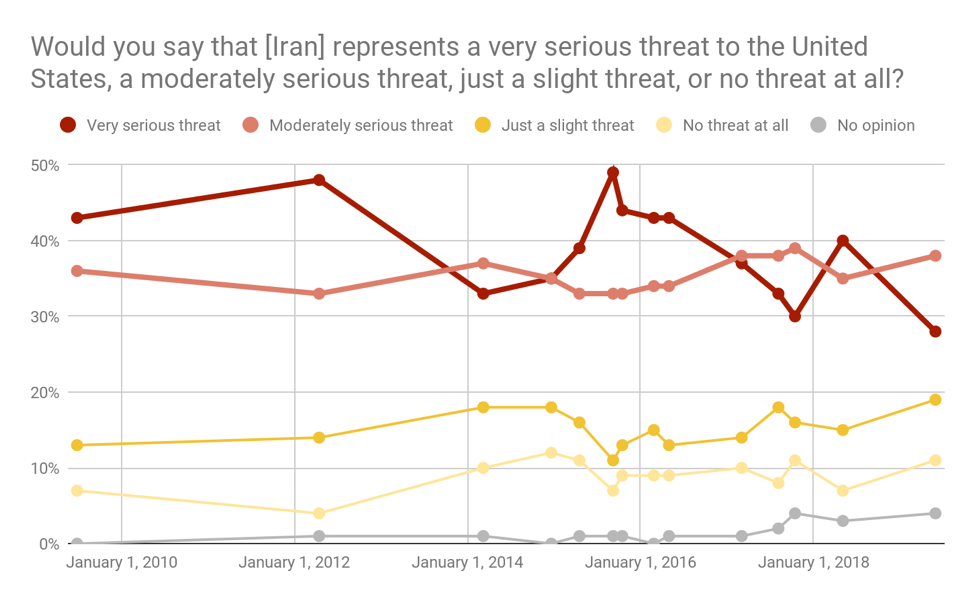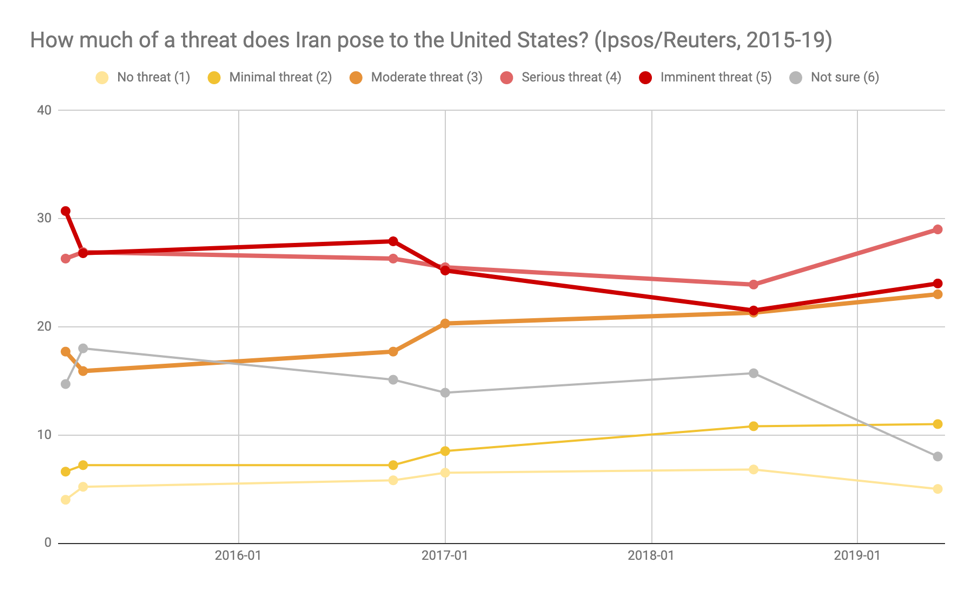by Eva Galanes-Rosenbaum
Tensions between the United States and Iran have risen alarmingly fast in the last week. Many experts have been on tenterhooks, since President Trump pulled the United States out of the nuclear deal with Iran (the Joint Comprehensive Plan of Action or JCPOA), that the current administration will provoke an armed conflict with the Persian state.
But how do average Americans think about Iran now, and how might they react if military action were taken?
Americans saw Iran as a threat for years leading up to the Iran Deal.
In spring 2015, as negotiations over Iran’s nuclear program neared their successful conclusion, Americans saw Iran as unfriendly and a threat—as they had since at least the late 1980s.
An Ipsos/Reuters poll in March 2015 found that 57 percent rated Iran a level-4 or 5 (imminent) threat to the United States. In April 2015, CNN found that 72 percent rated Iran as a very (39 percent) or somewhat serious threat (33 percent).
Gallup’s February 2015 poll found that 77 percent saw Iran’s development of nuclear weapons as a critical threat to the vital interests of the United States, with an additional 16 percent saying that such a development would be an important but not critical threat. Quinnipiac found both nationally and in its polls of six swing states that around 65 percent of the public considered Iran’s nuclear program to be a major threat, with an additional quarter saying it was a minor threat.
From 2006 to 2012, Gallup found that a plurality of Americans named Iran as the greatest U.S. enemy—about a quarter each year, rising to 32 percent in 2012. But in 2014 (as negotiations were getting under way) the plurality named China; in February 2015 (after over a year of negotiating with Iran), the plurality named Russia, with only 9 percent naming Iran.
Fewer Americans see Iran as a grave threat, but at least half still do.
In February 2018, only 7 percent named Iran as the greatest U.S. enemy. The results were similar this year, with 9 percent naming Iran. In the intervening years, attention has shifted to other adversaries: North Korea, Russia, and China.
But Americans’ perceptions of Iran as a “very serious threat” have also moved in the last year. CNN’s longitudinal dataset shows a downtick in how many Americans put Iran in the highest category of threat (very serious/imminent): down 12 points since May 2018, from 40 percent to 28 percent.
Ipsos/Reuters also conducted a poll on Iran around the same time (May 2019) and found that 53 percent rated Iran at a level-4 or -5 (imminent) threat. In July 2018, the results were similar but slightly lower: 47 percent at 4 or 5 (in other words, a slight 2018–19 uptick). Compared with the March 2015 numbers above, fewer Americans are thinking of Iran as an imminent threat than before—but not by much.
Public fears about Iran have not gone away, and could rise again.
A concerted anti-Iran campaign might easily ratchet up Americans’ fear level and sense of threat from Iran.
Note that there is only a slight uptick in the number of people saying that Iran is “just a slight threat” or “no threat at all” (yellow on the chart below). In the last year, CNN shows, most people moved from the top threat tier to the second tier (“a moderately serious threat”). Over time, that’s where most people have stayed, shifting between the top two tiers as U.S.-Iran tension rises and falls. Here are the last 10 years of CNN’s polling:
Ipsos/Reuters’ polling over the last five years shows something similar:
Americans no longer see Iran as their greatest enemy—in fact, it is fourth after Russia, China, and North Korea—but the public does still see it as a threat to the United States. It would not take much to encourage more Americans to see Iran as an imminent threat again, particularly in such a partisan political environment.
Remind Americans that they support diplomacy.
If you are in the business of working toward peace with Iran, this is pretty bad news. However, polls have also shown, consistently, that Americans support diplomacy and peaceful resolutions to conflicts. For example, see the Center for American Progress’ recent examination of American attitudes in foreign policy.
The memory of the Iraq War, which at least half of the population have long thought was a mistake, looms large in many Americans’ minds as an example of a bad military intervention. A war with Iran would be orders of magnitude larger and more catastrophic, and any kind of success is hardly guaranteed.
When speaking to regular people, remind them that most Americans would prefer a peaceful resolution to this conflict, that diplomacy is the best way to resolve conflicts with other nations, and that the United States can’t afford another costly and wasteful war (in lives or money). When speaking to policy influencers, remind them that Americans want diplomacy.
Eva Galanes-Rosenbaum is the director of media and opinion analysis for ReThink Media.








—What’s USA today?
1) Trump (the President BTW) doesn’t understand anything, reality is beyond his reach…
2) The G.O.P.is not only spineless but drifting in an awry way…
3) The low level in U.S. education is daunting, and looks irreparable…
Absolutely agree with Monty Ahwazi’s comment..”garbage in garbage out”. The U.S media prefers access to facts so they regurgitate what comes from AIPAC, the AIPAC controlled U.S congress and of course Trump’s white house. How many of our fellow citizens have eve bothered to learn the history of the US/ Iran saga…probably a minuscule. Think about the FIX news crowd-oh I meant Fox news. The administration in Iran are no boys scouts but the problem with the US needs to be objectively examined.
Why is it that US citizens and their elected leaders need to have enemies, and do their best to ensure peace is not achieved and negotiations are avoided?
“However, polls have also shown, consistently, that Americans support diplomacy and peaceful resolutions to conflicts.” LOL Never been seen!! Iran has not attacked anyone for centuries, Russia keeps trying to work with its “western partners” and is rebuffed and sanctioned, China is not allowed to compete (how unfair to do better than the USA!) so all are “enemies” to be punished.
The polls just tell us how easily the US public is controlled by the media and the PTB. NONE of the countries allegedly “enemies” is a threat to the USA-it is the USA which is a threat to them, as seems obvious to observers not under the delusion of “adversaries” which must be fought and/or feared.